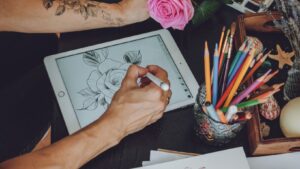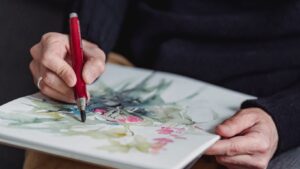Drawing art captivates the imagination, offering a universal language that transcends cultural barriers. From the earliest cave paintings to contemporary digital illustrations, drawing has been a fundamental form of expression and storytelling. It allows artists to bring their visions to life, capturing emotions and ideas with just a few strokes.
The beauty of drawing lies in its simplicity and accessibility. All it takes is a pencil and paper to start creating, making it an inviting medium for beginners and seasoned artists alike. Whether it’s a detailed portrait or an abstract doodle, drawing encourages exploration and experimentation.
In today’s fast-paced digital age, drawing remains a powerful tool for communication and creativity. As more people seek ways to unwind and express themselves, the timeless art of drawing continues to inspire and connect individuals across the globe.
Drawing:v04hso9zvvq= Art
 Drawing art dates back to prehistoric times when humans used cave paintings to depict daily life and beliefs. These ancient drawings, found in regions like Lascaux, set the foundation for visual storytelling. In ancient Egypt, artists used papyrus to record religious and daily scenes, while Greeks and Romans developed techniques to create realistic portraits on vases and walls. During the Middle Ages, drawing art evolved with illuminated manuscripts, blending text with elaborate illustrations.
Drawing art dates back to prehistoric times when humans used cave paintings to depict daily life and beliefs. These ancient drawings, found in regions like Lascaux, set the foundation for visual storytelling. In ancient Egypt, artists used papyrus to record religious and daily scenes, while Greeks and Romans developed techniques to create realistic portraits on vases and walls. During the Middle Ages, drawing art evolved with illuminated manuscripts, blending text with elaborate illustrations.
The Renaissance marked a significant turning point for drawing art, as artists like Leonardo da Vinci and Michelangelo used sketches to explore human anatomy and perspective. This period elevated drawing art from mere preparation for painting to a significant discipline. In the 19th century, the invention of pencils and easel paintings brought further advancements, enabling artists to create more detailed and expressive works.
Modern drawing art embraced new materials and methods, transitioning into contemporary forms, including digital illustrations. Despite technological changes, the fundamental essence of drawing art as a powerful tool for communication and artistry remains unchanged.
Techniques And Mediums
 Drawing art encompasses a diverse range of techniques and mediums, from traditional to digital. Pencil sketching and charcoal shading stand as classic methods, allowing for intricate detailing and depth. Watercolor pencils and pastels add vibrant colors, enabling artists to explore a spectrum of hues in their compositions.
Drawing art encompasses a diverse range of techniques and mediums, from traditional to digital. Pencil sketching and charcoal shading stand as classic methods, allowing for intricate detailing and depth. Watercolor pencils and pastels add vibrant colors, enabling artists to explore a spectrum of hues in their compositions.
In contrast, ink drawing brings bold lines and striking contrasts, often used in comic book art and calligraphy. Modern techniques involve digital mediums like graphic tablets and software such as Adobe Illustrator, offering endless possibilities for creativity and precision.
Cross-hatching and stippling are essential techniques in drawing art, providing texture and tonal variation. Artists often experiment with mixed media, combining different elements like ink and watercolor to achieve unique effects. Regardless of the medium chosen, drawing art techniques require practice and experimentation, continually pushing the boundaries of artistic expression.
Styles And Movements
 Drawing art reflects various styles and movements that have shaped its evolution. Modernism influenced drawing art by emphasizing abstract forms and new perspectives. Cubism, with pioneers like Pablo Picasso, challenged traditional representations by depicting subjects from multiple angles. Surrealism, through artists like Salvador Dali, combined dreamlike imagery with unexpected juxtapositions. Drawing:v04hso9zvvq= art also encompasses Impressionism, which captured fleeting light and movement, and Romanticism, highlighting emotion through dramatic scenes.
Drawing art reflects various styles and movements that have shaped its evolution. Modernism influenced drawing art by emphasizing abstract forms and new perspectives. Cubism, with pioneers like Pablo Picasso, challenged traditional representations by depicting subjects from multiple angles. Surrealism, through artists like Salvador Dali, combined dreamlike imagery with unexpected juxtapositions. Drawing:v04hso9zvvq= art also encompasses Impressionism, which captured fleeting light and movement, and Romanticism, highlighting emotion through dramatic scenes.
In the realm of contemporary drawing art, Street Art transforms urban spaces with detailed murals, while Minimalism strips art down to its essentials, focusing on simplicity and form. The growing popularity of Pop Art brought vibrant colors and bold compositions into drawing art, making it accessible and relatable. Each movement has enriched drawing art by offering diverse techniques and innovations, ensuring it adapts and thrives across generations.
Tools For Drawing:v04hso9zvvq= Art
Drawing art continues to evolve, embracing both traditional and modern tools to enhance creativity and expression. From simple pencils and charcoal to advanced digital tablets and software, artists have a vast array of options to explore their artistic visions. Each tool offers unique possibilities, allowing artists to experiment with techniques and styles that push the boundaries of their creativity. Whether it’s the tactile feel of paper or the versatility of digital platforms, the tools for drawing art are as diverse as the artists who wield them, ensuring that this timeless form of expression remains vibrant and relevant in an ever-changing world.
